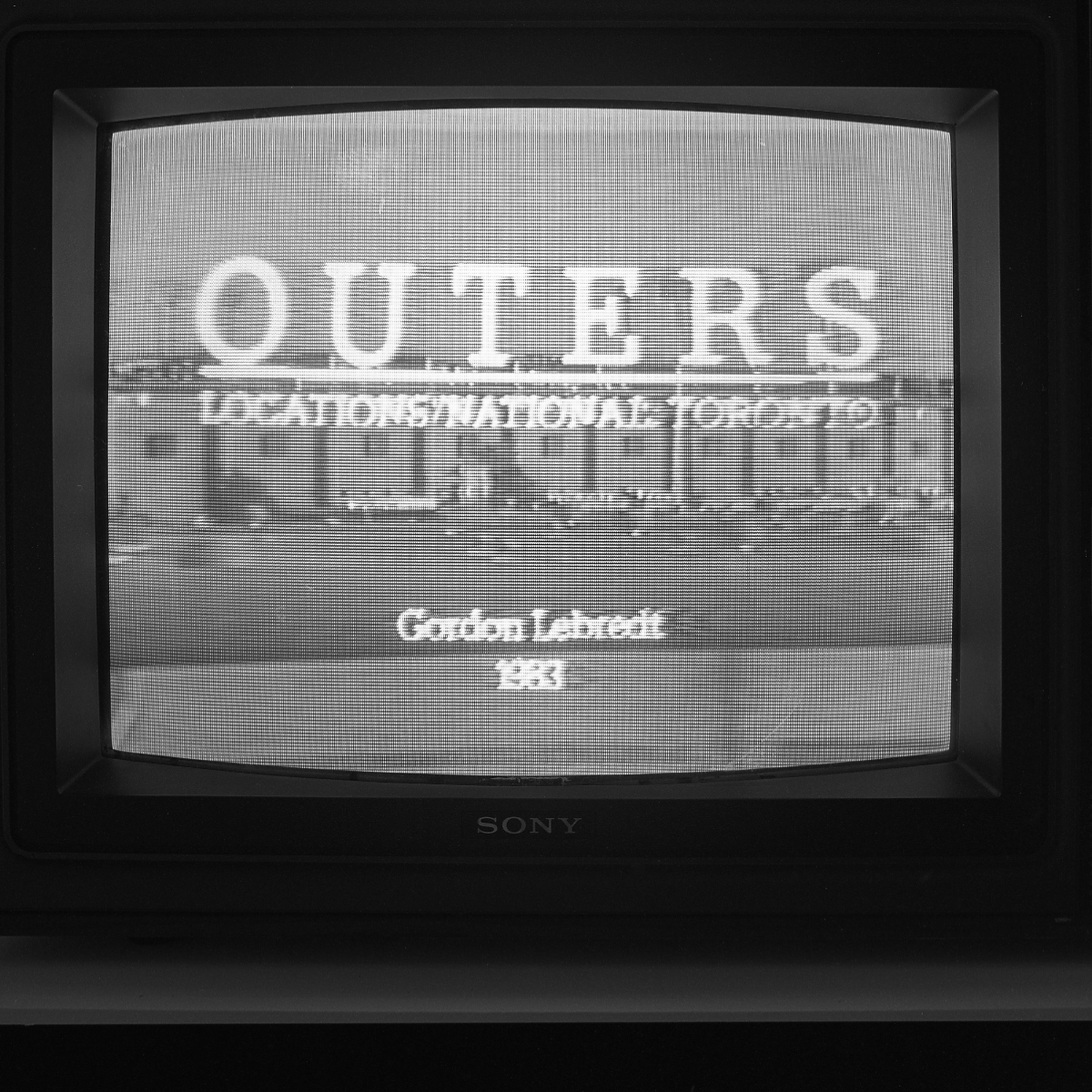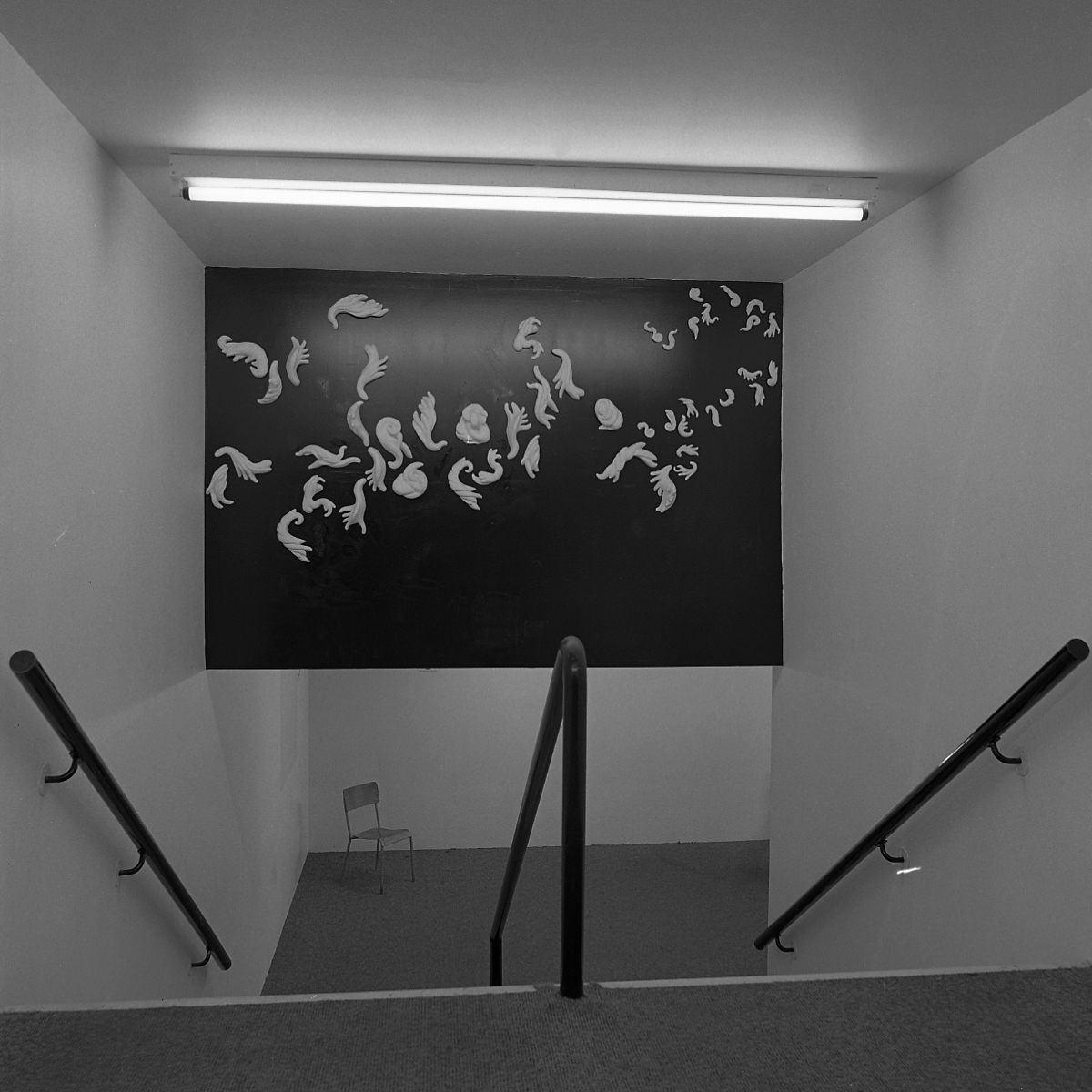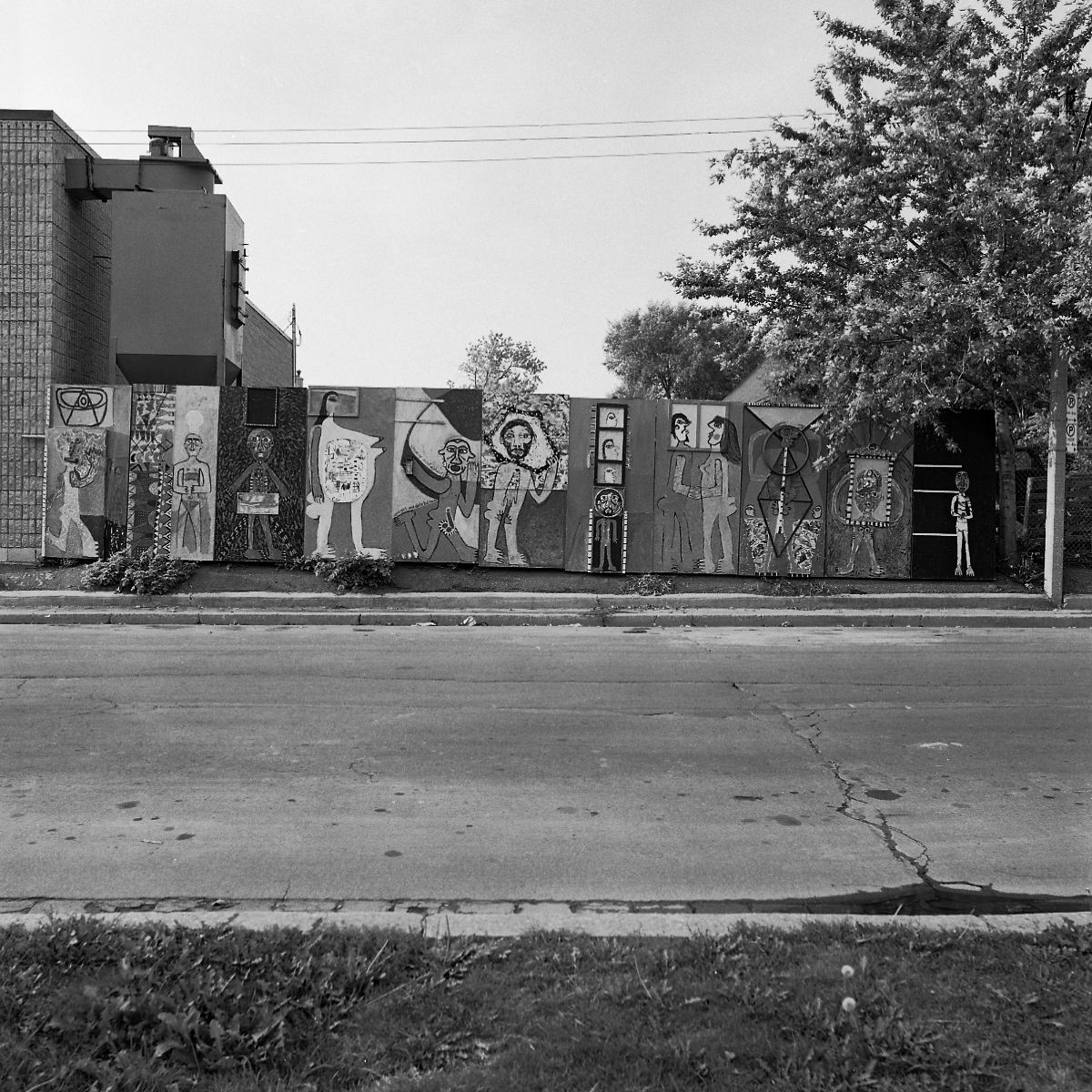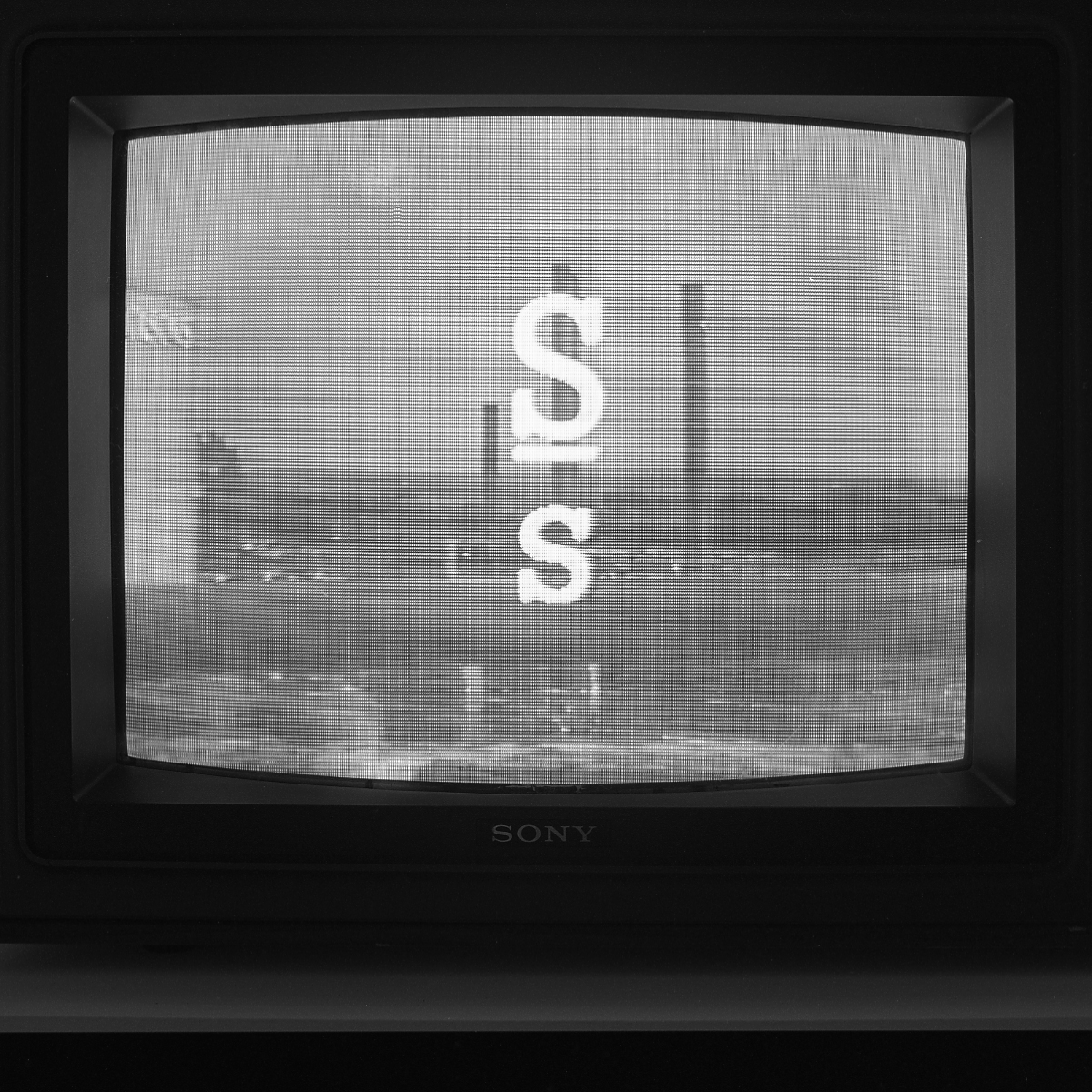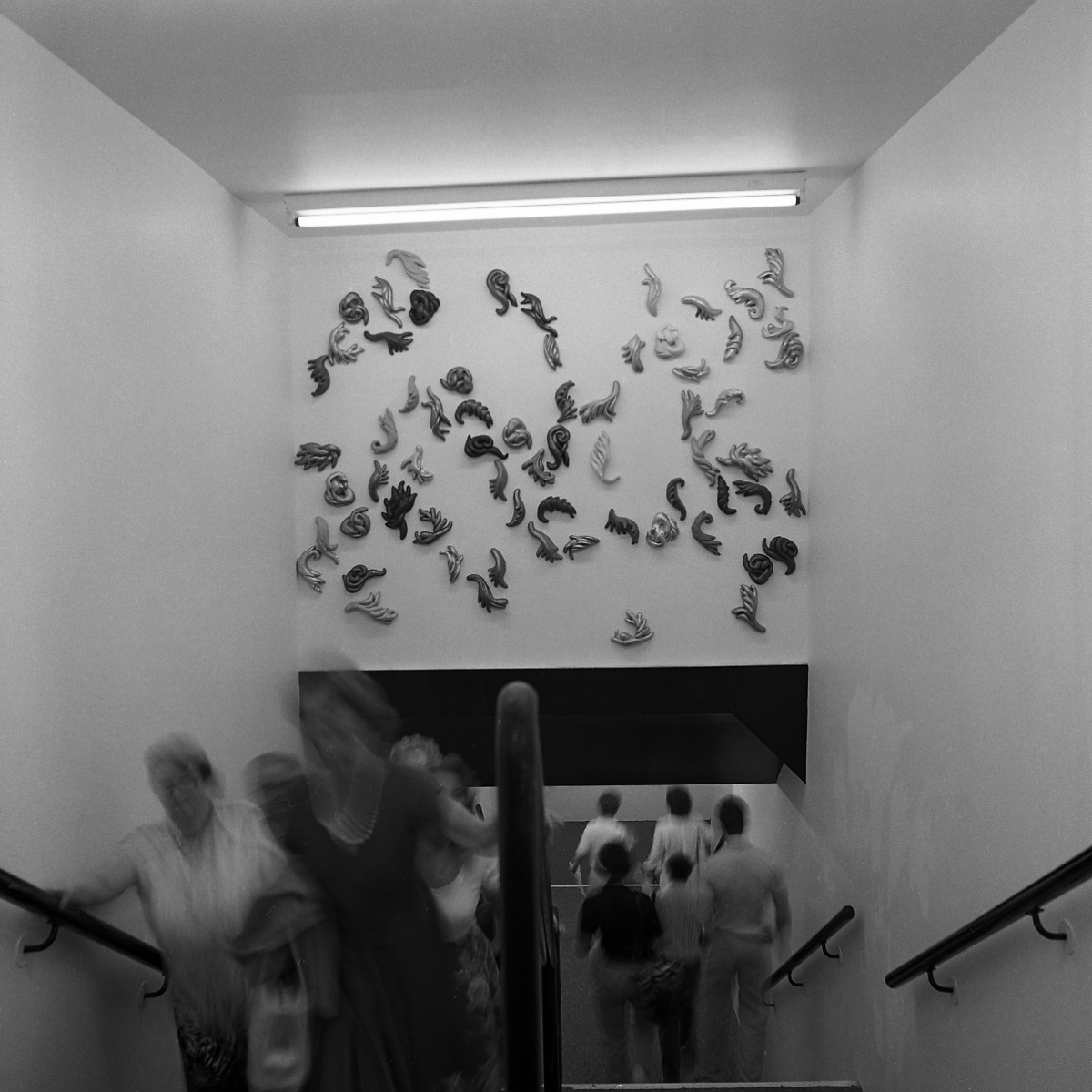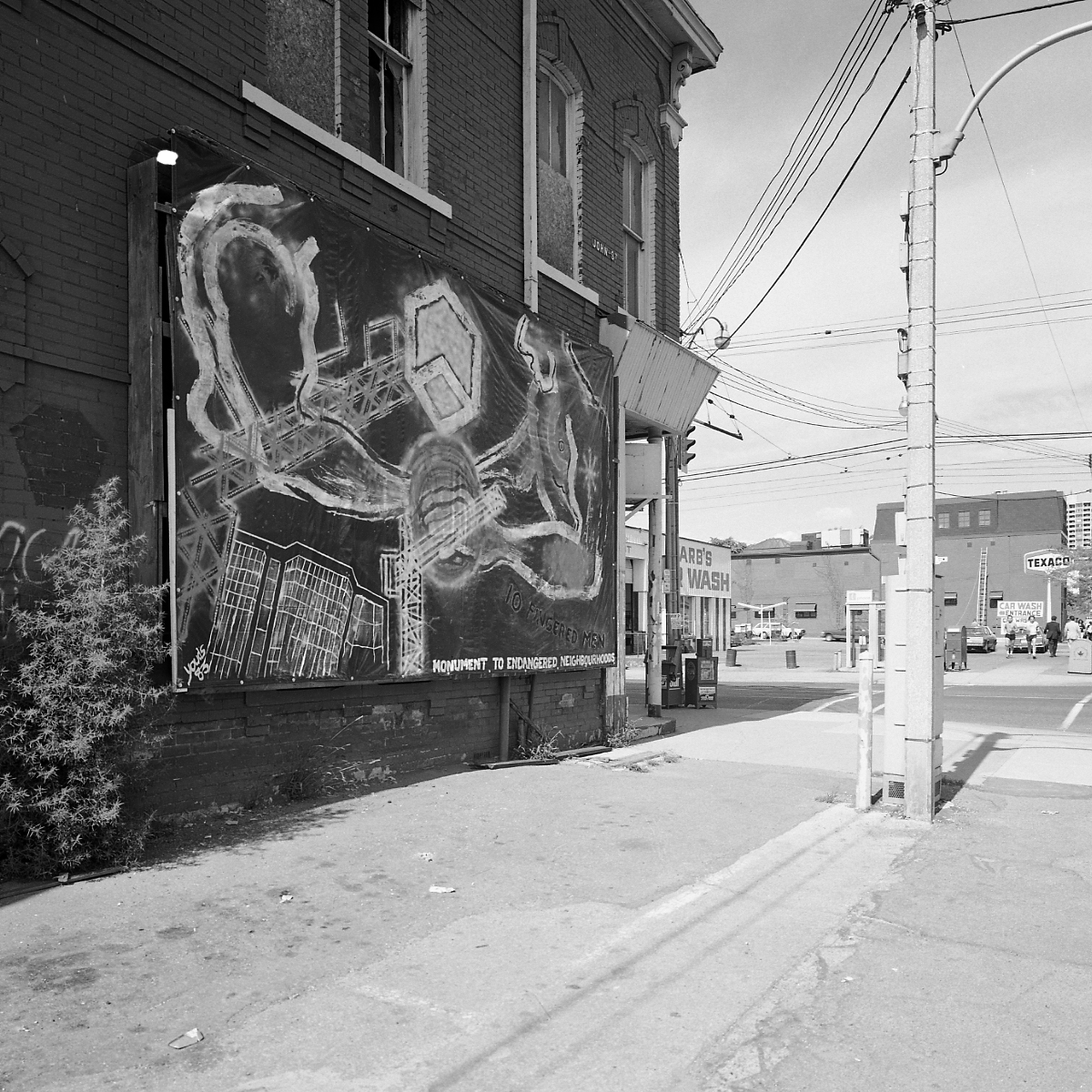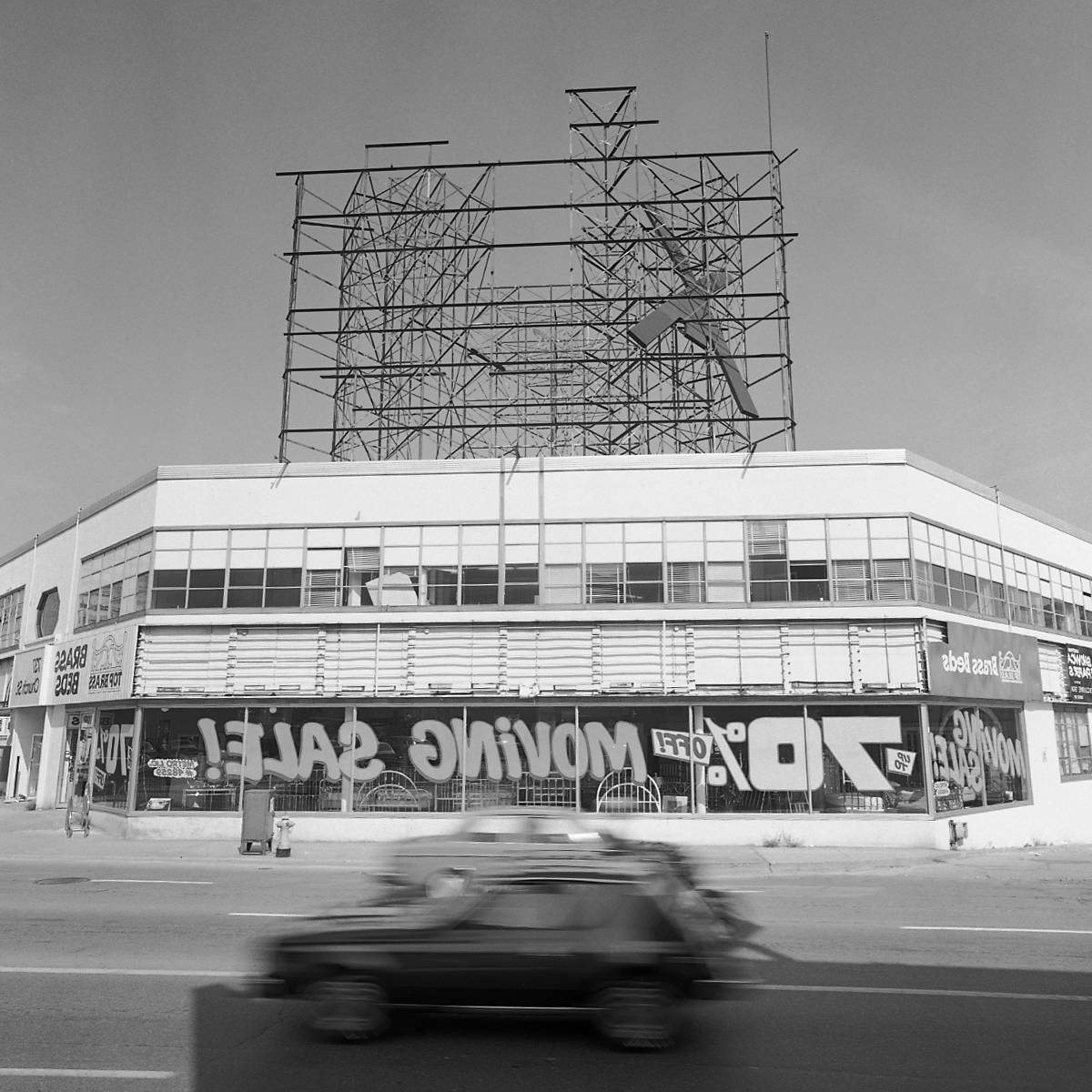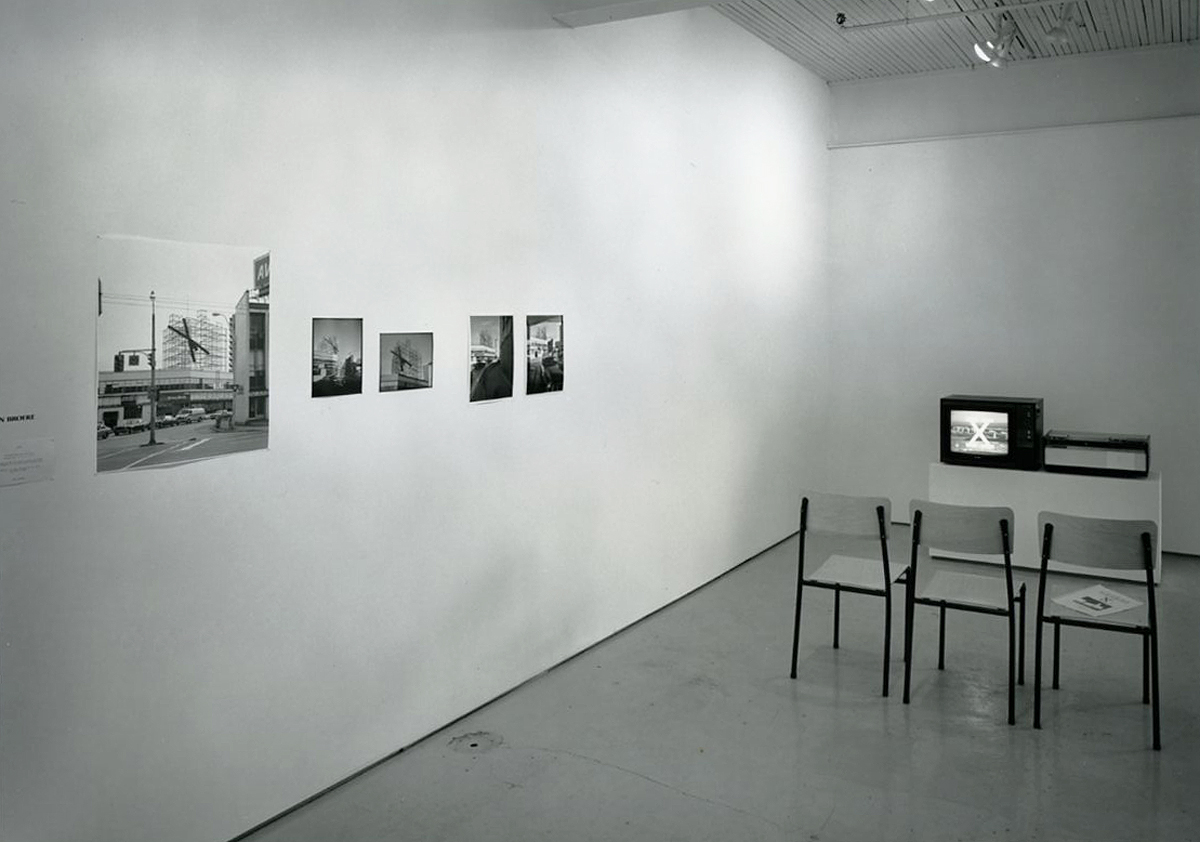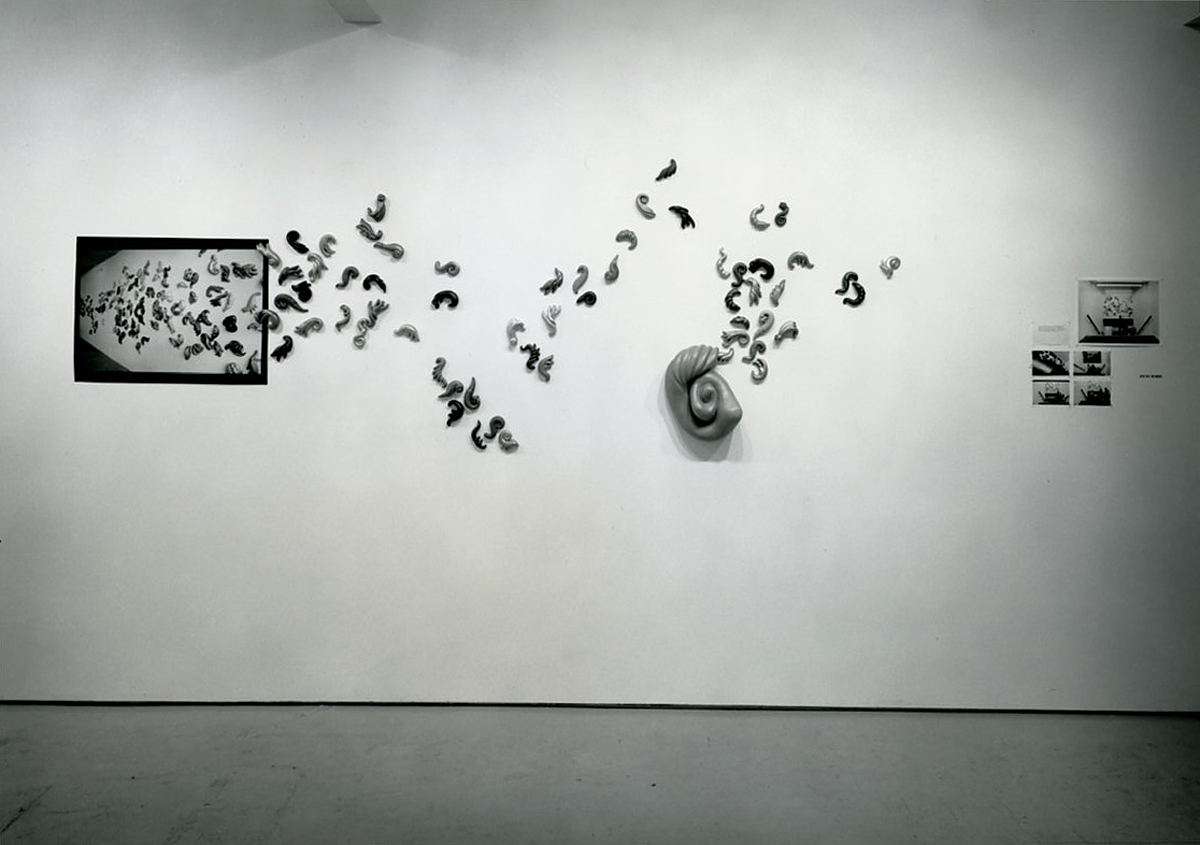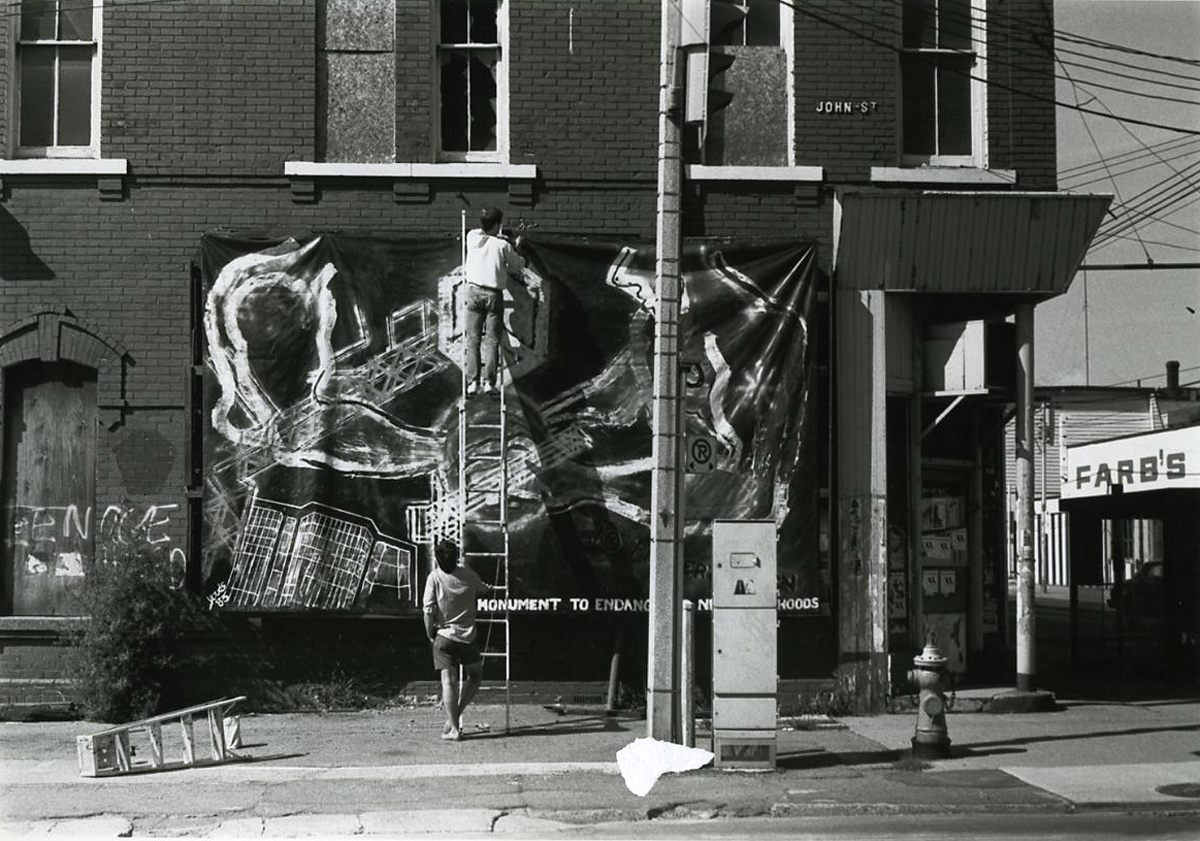On & Offsite
Locations/National: Toronto Segment
Works for the Toronto segment of Locations/National have now been selected and installation will begin during the first week of September, 1983. The project offers the artists the opportunity to expose their work to a broad audience as all projects will be located outside the gallery in public spaces. In addition, documentation of this work will be included in an exhibition at Mercer Union from September 20 through October 8, 1983. This exhibition will also include documentation of the works from the other four cities participating in the project: Victoria, Calgary, Montreal, Halifax.
The human form becomes a sign or symbol that shifts the usage of the billboard from advertising to conveying information that is both personal and social."
This work will be installed at the north/east corner of Yonge and Davenport. (Installation process has begun as of August 20, 1983)
I will invite the public to participate (through advertising) by donating time, objects and materials that I will use in my work."
This installation will be located at the Victoria Memorial Park on Wellington Street.
"Swamp" will be located at the south end of the temporary entrance way to the C.N. tower. It will be situated above two staircase landings at the south end of the temporary entrance way.
GORDON LEBREDT
(Note: How to place this overture, this prefatory gesture which, if indeed it begins in advance of the work to follow, can only be posed, here and now, as the opening to a provisional account, that is, to a recounting?)
Inside the space of the gallery, OUTERS traces out a fictional account to an abandoned architectural project and the phantom-object that once occupied the site.
For the most part, the tape documents the excursion which will take the narrator to the moment of encounter, to the place where the story will really begin.
Outside, voice and camera drive through the landscape. All reference to an actual destination is suppressed; but along the way a semblance or image of one is fashioned. The "ghost" of the abandoned site, the point around which this excessive and impossible tale revolves, appears only once. It takes place, in the final moments of the narrator's terminal(?) fall into site.
So begins the overture to an infinite movement: the encounter itself.
Gordon Lebredt's video will be installed at Mercer Union. (based on the former site of the seven story apartment complex located on the Bayview Avenue Extension)
Robert Youds' painting will be installed on the south/west corner of John Street and King Street.
CATALOGUE TEXT:
LOCATIONS/NATIONAL
SITES/LOCATIONS
Published by Mercer Union, 1984
INTRODUCTION
by Robert Wiens
Mercer Union has sponsored three Locations shows of on-site works in Toronto. The previous two were held in 1979 and 1980. The current exhibition is defined differently by the gallery in that it is part of a national exhibition held in conjunction with other artist run centres across Canada, and secondly, has been limited to a smaller number of participating artists. The artists also have brought an added dimension to the current Locations exhibition in that the work is more highly articulated in terms of public perception, that is, it is situated on more highly visible sites, and more apt to actively confront the viewer with issues important to artwork in a public/urban context. A number of works address themselves to specifically urban issues such as corporate land development. For instance, Robert Youds painted a hanging mural entitled Ten Fingered Men, Monument to More Lost Neighbourhoods. Brad Colden's work remains in maquette form, largely because his in tended architectural renovation to the TD bank tower, of adding residential-type aluminum awnings to entrance ways, has been deemed unacceptable by bank officials. Perhaps even in its failure to gain sanction, this work succeeds in reminding us that the tower of power is not to be tampered with, and any attempt to humanize its architecture would also belittle its corporate image status. Peter Blendell and John Broere chose to work on sites that have fallen in to disuse and neglect. In Blendell's case a circular asphalt road has been constructed amid the CN rail yards at the Bathurst Street Bridge. The bridge provides the viewer with an excellent vantage point with which to view the work. Peter Blendell has used this site for a number of his urban earth works, which in the past, were often located in relation to topographical features of the landscape and/or compass points. The present work distinguishes itself as an asphalt ring, a road without function amid the highways, bridges, tracks and factories in its vicinity. John Broere's installation incorporates an unused steel billboard frame as a support for a falling human form. In the past this frame held a large corporate logo for an automobile dealership. Presently, the frame and building on which it is located are slated for demolition. Broere's "sign" piece exists in this context and in the broader connotation of its symbol imagery. Alan Glicksman also incorporates objects of urban neglect in his work. However, in Glicksman's case, they are found objects and debris integrated into a figurative assemblage mounted on chip board panels, his strong imagery gives a street-level rawness to his work and places painting in a more public and accessible domain. Situated in a long entrance tunnel to the CN tower Dyan Marie's wall-mounted plaster forms, painted in metallic colours, tended to break up an otherwise long, and uneventful length of the dry-walled corridor. Although their protoplasmic or vaguely intestinal looking shapes defy a decorative reading of the work they transform this tunnel in an interesting way, and speak for the~ viability of art in an interior public setting. Gordon Lebredt's videotape goes beyond the notion of altering a site and confines itself to a video document, encountering the leveled plot of land where the "Bayview Ghost" once stood: An unfinished apartment building shrouded in a twenty-year controversy of land mismanagement and dereliction.
The importance of a show like Locations, is to bring art into a more public context, out of its often problematic situation of private appropriation. Interestingly enough, many of the works met with problems in their installation, specifically in procuring sites for use from landholders. At least one of the pieces in the Toronto show was installed without sanction. Another was disapproved and remained unfinished. Others met acceptance only after lengthy discussion and persistence on the part of the artists and the gallery. Once the works were installed no problems were mentioned, and in most cases, were accompanied with the approval of the property owners and the public. Whether the Locations pieces were seen as an exhibition or stumbled upon by accident, the viewer was given a chance to see artwork in an urban and public context. Within this urban setting, which is so inundated with advertising, which perhaps we try to lock out of our attention, it is welcome to come upon a statement more human in its quest, not seeking commercial promotion, but existing to be viewed as a statement within the context of its setting.
Phillip Monk
Vanguard, February 1984
Locations is an idea whose time has come and gone . In its own proper time, its concept could be questioned. Now when no one respects the original concept and context in a new economy of art, it should be rigorously criticized to find what is left of its critique of the gallery/commodity system. Or it should be interred as an historical genre, abandoned to the ruins of its intervention and photographic documentation. On this occasion of Locations, its form is denied while its currency is played upon. Whether the Toronto Locations indicates a shift from site specific work to public art, it is the former that has set the terms for what is exterior to the gallery. Placing gallery art outside does not make it public.
This is the first Locations/National, uniting locality to a chain of artists-run spaces from sea to sea, joining the specific to a notion of communication, as if site-specificity has not become contradictory enough here. It is the third Locations exhibition for Mercer Union, as site specificity was an extension of its early post minimalist direction. The work here is distant from any notion of site-specificity. It is located in name only, in the sense that one needs a map to get there; the work does not come out of the site.
The work in fact does not distance itself from the gallery at all, however far from it it might be. Inside and outside are blurred; the work outside the gallery is not only documented inside, it is addended by similar pieces. This only proves that the work outside could as easily have been shown inside. In denying the conventions of site specificity, the work also denies its own gallery conventions. It assumes that art can be located anywhere (its context does not have to be marked); that in a return to the image and figure it can communicate without conventions. This is its democratic gesture to the people. What constitutes public art? None of the work addresses that question and cannot under the conditions of art production it has accepted.
Was the notion 'outside the gallery'' ever possible even under the original claims of site specific work? Clearly the answer is no, if we mean a pure outside uninfected by the inside. An ideal gallery context always travels with the work however far from the gallery. In this exhibition none of the work is site-specific in the original sense. We find no interest in the city as utopia or ruin. No work constructs itself from the urban traces of a site. None of the work incorporates the reproducible systems of communication that are part of the city site. Instead it values the handmade and humanist.
In short, "New Image'' paintings have been hung outside. Alan Glicksman painted panels in one site and moved them to another for installation. He incorporated waste fragments from the Site in these naive panels. This is as much a studio convention (Cubism, Dadaism, Assemblage etc .) as the Picassoid distortions of the paintings, so-called representations of local inhabitants passersby would be hard pressed to identify.
Robert Youds' painting, Ten Fingered Men (Monument to endangered neighbourhoods) placed in an abandoned billboard at the edge of downtown commercial development is an attempt at an art with a message . Its sub-title says it all, because the vaguely referential work does not.
John Broere has chosen to inhabit a billboard structure as well. but he uses that physical structure as a ground for his image rather than as a frame for a painting. He has partly reduced a personal expression to a sign form: a black stick figure enmeshed in the grid structure. Its message is double-edged: the figure can be reversed to become a pair of scissors. The work, however, remains an expressive metaphor in the way that a cry is a sign that indicates need, but stylised in a work it becomes an individual expression, not a common sign or shared symbol. Only a message value is lifted here as in Youds, advertising artist's intent, not questioning advertisement structures and functions.
The variously painted fetal and vegetal shapes of Dyan Marie's Lust for Life/Swamp are pretty things. Using them to recall primal terror and beauty, however, is pushing decoration past its limits. Placed on sterile white plaster walls inside the temporary entrance to the CN Tower, they might as well have been in an art gallery (where we do find their miniature cousins in Mercer Union). Only the number of people passing makes a difference between the mundane and the metaphorical, the site and the gallery.
Peter Blendell, whose site-specific work was in the first Locations exhibition, shows the passage this type of work has taken from the denotative to the connotative. This new work does not inscribe a site as much as overlay it; it does not simply denote it as an indexical mark but refers to other things around it: it is a circular asphalt ''road'' between an expressway, a viaduct and railway tracks. It too now has a message: 'An image of destiny will be added to a neighbour hood which has now only destination."
I have said that none of the artists dealt with the trace-structure associated with site-specific work. This is not exactly true. Although perhaps ''trace ' is too easy a coincidence here, Gordon Lebredt pursues it without leaving the gallery. His videotape Outers attempts to ''deconstruct'' the dialectic of primary site and secondary documentation, that is, the outside and the inside. Cancelling the primary site (with its myth of presence and origin), in a gesture eliding Derrida and Lacan, Lebredt seems to give value to the documentary remainder. He has come too late. This was already accomplished ''originally'' with the first non-site gallery or magazine documentation of earthworks fifteen years ago. Cancelling here only restores an academic dialectic although Lebredt's flourish is to question that there is a hors texte. In short, this work is a reserved, at times almost embarrassed, Derrideanism as the voice on the tape almost falters in its endless appropriation of the supply of deconstructive signifiers. The narrative chain of the videotape has borrowed from the strategic field of Derrida's texts without exceeding them. In crossing out the site, Lebredt has not killed the Father. He remains within this text and thus has not broken from the idealizing presence of the art gallery. The most radical gesture in Locations restores the most traditional notion of the gallery.

